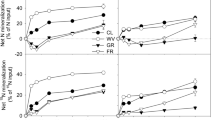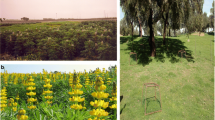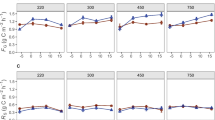Abstract
The turnover of N derived from rhizodeposition of faba bean (Vicia faba L.), pea (Pisum sativum L.) and white lupin (Lupinus albus L.) and the effects of the rhizodeposition on the subsequent C and N turnover of its crop residues were investigated in an incubation experiment (168 days, 15 °C). A sandy loam soil for the experiment was either stored at 6 °C or planted with the respective grain legume in pots. Legumes were in situ 15N stem labelled during growth and visible roots were removed at maturity. The remaining plant-derived N in soil was defined as N rhizodeposition. In the experiment the turnover of C and N was compared in soils with and without previous growth of three legumes and with and without incorporation of crop residues. After 168 days, 21% (lupin), 26% (faba bean) and 27% (pea) of rhizodeposition N was mineralised in the treatments without crop residues. A smaller amount of 15–17% was present as microbial biomass and between 30 and 55% of mineralised rhizodeposition N was present as microbial residue pool, which consists of microbial exoenzymes, mucous substances and dead microbial biomass. The effect of rhizodeposition on the C and N turnover of crop residues was inconsistent. Rhizodeposition increased the crop residue C mineralisation only in the lupin treatment; a similar pattern was found for microbial C, whereas the microbial N was increased by rhizodeposition in all treatments. The recovery of residual 15N in the microbial and mineral N pool was similar between the treatments containing only labelled crop residues and labelled crop residues + labelled rhizodeposits. This indicates a similar decomposability of both rhizodeposition N and crop residue N and may be attributable to an immobilisation of both N sources (rhizodeposits and crop residues) as microbial residues and a subsequent remineralisation mainly from this pool.








Similar content being viewed by others
Abbreviations
- C or Ndec :
-
C or N decomposed from residues
- C or Nmic :
-
microbial C or N
- C or Nmicres :
-
microbial residue C or N
- C or Nmin :
-
mineralised C or N
- C or Ninput :
-
added C or N as crop residues and/or rhizodeposits
- dfr:
-
derived from residues
- dfR:
-
derived from rhizodeposition
- Ndfr:
-
N derived from residues
- NdfR:
-
N derived from rhizodeposition
- Nloss :
-
losses of N derived from residues
- SOM:
-
soil organic matter
- WHC:
-
water holding capacity
References
Aneja M, Sharma S, Mayer J, Schloter M, Munch JC (2003) RNA fingerprinting of microbial community in the rhizosphere soil of grain legumes. J Appl Microbiol (in press)
Bottner P, Pansu M, Sallih Z (1999) Modelling the effect of active roots on soil organic matter turnover. Plant Soil 216:15–25
Cabrera ML, Beare MH (1993) Alkaline persulfate oxidation for determining total nitrogen in microbial biomass extracts. Soil Sci Soc Am J 57:1007–1012
Cheshire MV, Bedrock CN, Williams BL, Chapman SJ, Solntseva I, Thomsen I (1999) The immobilization of nitrogen by straw decomposing in soil. Eur J Soil Sci 50:329–341
Collins HP, Elliott LF, Rickman RW, Bezdicek DF, Papendick RI (1990) Decomposition and interactions among wheat residue components. Soil Sci Soc Am J 54:780–785
De Neergaard A, Magid J (2001) Influence of the rhizosphere on microbial biomass and recently formed organic matter. Eur J Soil Sci 52:377–384
De Nobili M, Contin M, Mondini C, Brookes PC (2001) Soil microbial biomass is triggered into activity by trace amounts of substrate. Soil Biol Biochem 33:1163–1170
Degens BP (1998) Microbial functional diversity can be influenced by the addition of simple organic substrates to soil. Soil Biol Biochem 30:1981–1988
Dormaar JF (1990) Effect of active roots on the decomposition of soil organic materials. Biol Fertil Soils 10:121–126
Garland JL (1996) Patterns of potential C source utilization by rhizosphere communities. Soil Biol Biochem 28:223–230
Goerges T, Dittert K (1998) Improved diffusion technique for 15N:14N analysis of ammonium and nitrate from aqueous samples by stable isotope spectrometry. Commun Soil Sci Plant Anal 29:361–368
Gransee A, Wittenmayer L (2000) Qualitative and quantitative analysis of water-soluble root exudates in relation to plant species and development. J Plant Nutr Soil Sci 163:381–385
Heal OW, Anderson JM, Swift MJ (1997) Plant litter quality and decomposition: an historical overview. In: Cadisch G, Giller KE (eds) Driven by nature: plant litter quality and decomposition. CAB International, Wallingford, pp 3–30
Helal HM, Sauerbeck DR (1989) Carbon turnover in the rhizosphere. Z Pflanz Bodenkunde 152:211–216
Høgh-Jensen H, Schjoerring JK (2001) Rhizodeposition of nitrogen by red clover, white clover and ryegrass leys. Soil Biol Biochem 33:439–448
Hütsch BW, Augustin J, Merbach W (2002) Plant rhizodeposition—an important source for carbon turnover in soils. J Plant Nutr Soil Sci 165:397–407
Janzen HH (1990) Deposition of nitrogen into the rhizosphere by wheat roots. Soil Biol Biochem 22:1155–1160
Jensen ES (1996) Rhizodeposition of N by pea and barley and its effect on soil N dynamics. Soil Biol Biochem 28:65–71
Joergensen RG, Schmaedeke F, Windhorst K, Meyer B (1995) Biomass and activity of microorganisms in a fuel-oil contaminated soil. Soil Biol Biochem 27:1137–1143
Jones DL (1998) Organic acids in the rhizosphere—a critical review. Plant Soil 205:25–44
Jörgensen RG (1996) The fumigation-extraction method to estimate soil microbial biomass: calibration of the kec value. Soil Biol Biochem 28:25–31
Jörgensen RG, Müller T (1996) The fumigation-extraction method to estimate soil microbial biomass: calibration of the ken value. Soil Biol Biochem 28:33–37
Kuzyakov Y (2002) Review: factors affecting rhizosphere priming effects. J Plant Nutr Soil Sci 165:382–396
Kuzyakov Y, Domanski G (2000) Carbon input by plants into the soil. Review. J Plant Nutr Soil Sci 163:421–431
Mayer J, Buegger F, Jensen ES, Schloter M, Heß J (2003a) Estimating N rhizodeposition of grain legumes using a 15N in situ stem labelling method. Soil Biol Biochem 35:21–28
Mayer J, Buegger F, Jensen ES, Schloter M, Heß J (2003b) Residual nitrogen contribution from grain legumes to succeeding wheat and rape and related microbial process. Plant Soil 255:541–554
Merckx R, den Hartog A, Van Veen JA (1985) Turnover of root-derived material and related microbial biomass formation in soils of different texture. Soil Biol Biochem 17:565–569
Miethling R, Wieland G, Backhaus H, Tebbe CC (2000) Variation of microbial rhizosphere communities in response to crop species, soil origin, and inoculation with Sinorhizobium meliloti L33. Microbial Ecol 41:43–56
Molina JAE, Clapp CE, Linden DR, Allmaras RR, Layese MF, Dowdy RH, Cheng HH (2001) Modeling the incorporation of corn (Zea mays L.) carbon from roots and rhizodeposition into soil organic matter. Soil Biol Biochem 33:83–92
Owen AG, Jones DL (2001) Competition for amino acids between wheat roots and rhizosphere microorganisms and the role of amino acids in plant N acquisition. Soil Biol Biochem 33:651–657
Reid JB, Goss MJ (1981) Effect of living roots of different plant species on the aggregate stability of two arable soils. J Soil Sci 32:521–541
Reid JB, Goss MJ (1982) Suppression of decomposition of 14C-labelled plant roots in the presence of living roots of maize and perennial ryegrass. J Soil Sci 33:387–395
Rroco E, Mengel K (2000) Nitrogen losses from entire plants of spring wheat (Triticum aestivum) from tillering to maturation. Eur J Agron 13:101–110
Russell CA, Fillery IRP (1996) In situ 15N labelling of lupin below-ground biomass. Aust J Agr Res 47:1035–1046
Smalla K, Wieland G, Buchner A, Zock A, Parzy J, Kaiser S, Roskot N, Heuer H, Berg G (2001) Bulk and rhizosphere soil bacterial communities studied by denaturing gradient gel electrophoresis: plant-dependent enrichment and seasonal shifts revealed. Appl Environ Microb 67:4742–4751
Smalla K, Wachtendorf U, Heuer H, Liu W, Forney L (2002) Analysis of BIOLOG GN substrate utilization patterns by microbial communities. Appl Environ Microb 64:1220–1225
Sørensen P, Jensen ES (1991) Sequential diffusion of ammonium and nitrate from soil extracts to a polytetrafluoroethylene trap for 15N determination. Anal Chim Acta 252:201–203
Traoré O, Groleau-Renaud V, Plantureux S, Tubeileh A, Boeuf-Tremblay V (2000) Effect of root mucilage and modelled root exudates on soil structure. Eur J Soil Sci 51:575–581
Van Soest PJ (1963) Use of detergents in the analysis of fibrous feeds. II. A rapid method for the determination of fiber and lignin. J Assoc Off Anal Chem 46:829–835
Vance ED, Brookes PC, Jenkinson DS (1987) An extraction method for measuring soil microbial biomass C. Soil Biol Biochem 19:703–707
Wang J, Bakken LR (1997) Competition for nitrogen during decomposition of plant residues in soil: effect of spatial placement of N-rich and N-poor plant residues. Soil Biol Biochem 29:153–162
Zagal E (1994) Influence of light intensity on the distribution of carbon and consequent effects on mineralization of soil nitrogen in a barley (Hordeum vulgare L.)–soil system. Plant Soil 160:21–31
Acknowledgements
We would like to thank Anja Sawallisch, Elke Brüggemann-Kohaupt and Sabine Ahlers for their skilled technical assistance and Rainer Georg Jörgensen and Torsten Müller for valuable discussions. The study was supported by a research grant from the Deutsche Forschungsgemeinschaft (DFG), Bonn, Germany.
Author information
Authors and Affiliations
Corresponding author
Rights and permissions
About this article
Cite this article
Mayer, J., Buegger, F., Jensen, E.S. et al. Turnover of grain legume N rhizodeposits and effect of rhizodeposition on the turnover of crop residues. Biol Fertil Soils 39, 153–164 (2004). https://doi.org/10.1007/s00374-003-0694-2
Received:
Accepted:
Published:
Issue Date:
DOI: https://doi.org/10.1007/s00374-003-0694-2




